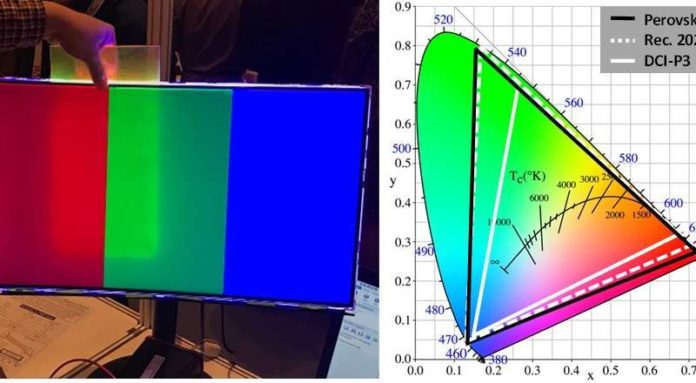Current commercial display technologies such as OLEDs (organic light-emitting diodes) and QLED (quantum dot light-emitting diodes) can only produce slightly more than 50 percent of the colors visible to the human eye. This limits the color reproduction that these displays can achieve.
Now, scientists at the National University of Singapore have developed a color-enhancement film that could bring richer and more natural colors to next-generation flat-panel electronic displays. More surprisingly, it can create more than 75 percent of all visible colors.
To demonstrate this technology, scientists used semiconductor material known as perovskites, which can be tuned by changing its chemical composition to emit light strongly and efficiently in a variety of colors. They then mixed nanometre-sized precious stones of the perovskite material with a liquid nanometer (the antecedent of plastics) and set off a polymerization response by enlightening the blend with white light.
Doing this, scientists could successfully manufacture an emphatically luminescent perovskite-polymer composite film that has a triple enhancement in radiance proficiency contrasted with an ordinary perovskite nanocrystal film. The enhanced radiance execution is a consequence of the expanded spatial partition between the perovskite nanocrystals in the polymer composite material, which keeps the diverting of vitality between gems to the damaged and non-emissive ones.
Scientists noted that the technology could allow perovskite materials to emit light more efficiently and consume less energy when deployed in a display product. Their color performance can enable next-generation televisions and monitors to achieve the higher quality Rec. 2020 color standard for ultra-high definition television (UHDTV), compared to the more limited DCI-P3 standard in current displays.
Dr. Wong Ying Chieh, a member of the research team, said, “An added advantage is that perovskites are easy to synthesize, potentially facilitating their scale-up and reducing the production cost of displays. The time taken for perovskite precursor chemicals to react and form nanocrystals is typically on the order of 10 seconds.”
“Perovskite materials can be coated and processed in a solution form which is similar to paints and can potentially be used in large-area displays. Although our materials are useful in enhancing the performance of televisions and mobile devices, my vision is to put them into wall-sized displays in our living or workspaces to create realistic virtual environments with rich and natural colors.”
Scientists are currently working with display companies to commercialize the perovskite color-enhancement film and hope to see the technology in consumer electronic products within the next two to three years.
Scientists have published their study in the journal Advanced Materials.
